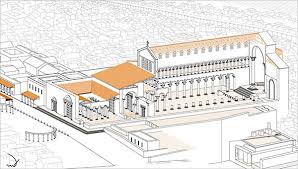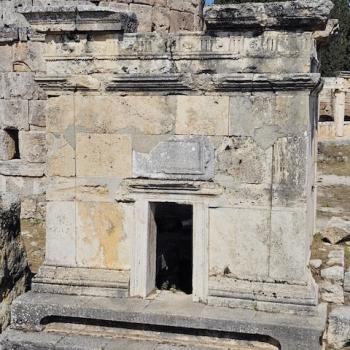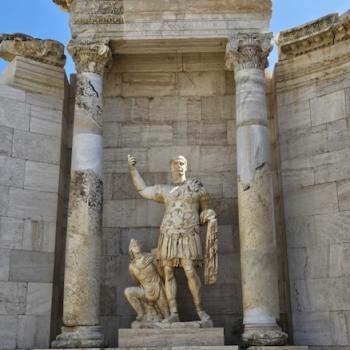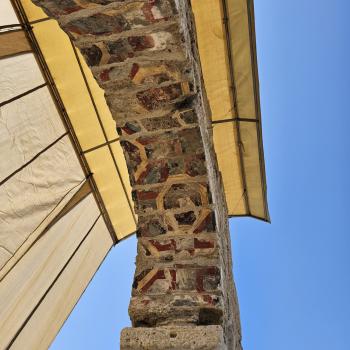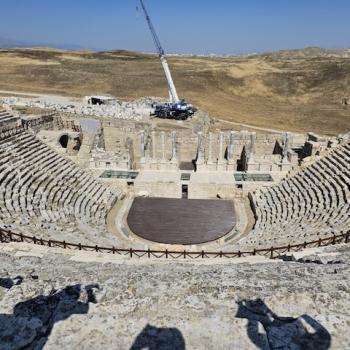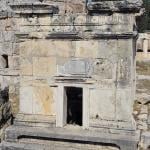Sometimes coincidences are not just coincidences. So I’m busy reading the latest issue of BAR (Biblical Archaeology Review) a magazine I regularly write for. I’m reading the fascinating article about what happened to the menorah and other sacred articles taken by Titus out of the Temple in Jerusalem and carted off to Rome in A.D. 70. It is an amazing story, and not quite 500 years later, it seems to bring us back to Jerusalem. More on this in a minute. Note the picture below— why is Mr. Gellman smiling? Well on the very last day of his excavations just north of the Damascus Gate he found this inscription mentioning Justinian and a priest named Constantine. It seems to be a dedication of a building in this case, a hostel for Christian pilgrims coming to visit another building Justinian built— the famous Nea Church. The inscription dates to about 550 A.D. near the date of the building of the Nea Church.
(picture courtesy of Amanda Borschel-Dan of the Times of Israel)
Here’s the link to the story about this inscription.
http://www.timesofisrael.com/once-in-a-lifetime-find-of-ancient-greek-inscription-uncovered-at-jerusalems-old-city-gate/
Now here’s the deal. When the relics of the Herodian temple were carted back to Rome for Titus’ triumphal procession (see the famous Titus arch in Rome which depicts this procession with said artifacts) the sacred objects were put in the new Temple of Peace for safe keeping. There they stayed at least until the fire in that Temple in about 192 A.D. (on all this see the article in BAR Vol. 43. no. 5 2017 by Fredric Brandfon entitled ‘Did the Temple Menorah come back to Jerusalem?’). The objects must have been rescued from the building because if we fast forward to 455 A.D. that is when the Vandals sacked Rome and carted off many of its imperial treasures. They took them to their base in Carthage in northern Africa (modern Tunisia). The Christian historian Procopius (500-560) who operated during the reign of Justinian, tells the tale. Now Justinian was all about rescuing Biblical relics, and making Jerusalem a fit place for Christian pilgrimage. You can see the mosaics of him and his wife on the second floor in Hagia Sophia in Istanbul=Constantinople. He was all about Christianizing the Byzantine Empire which included Jerusalem. So he dispatched his best general Belisarius, to rescue the relics from the Vandals. Belisarius conquered Carthage in 534 A.D. and brought home the booty. And then Procopius says about the booty “and among these were the treasures of the Jews, which Titus, the son of Vespasian…had brought to Rome after the capture of Jerusalem.”
This is where the story gets even more interesting. After all this, a Jew visited Justinian and told him the tale of a curse. The Temple treasures were cursed, and any city which held them would fall— first Rome, then Carthage, next Constantinople, unless the treasures were returned to Jerusalem. Here the story gets a little fuzzy, but we know that Justinian built the Nea Church just off the Cardo from the Damascus gate, not just for pilgrims to worship, but to come and see important Biblical relics. The theory is that the Nea Church was built to house the menorah and other objects rescued from Carthage, a church overseen by Priest Constantine, and now we know that very nearby the Damascus Gate, a hostel was built to house the pilgrims. But that is far from all.
The Nea Church was built on best-guess specs for what the Solomonic Temple looked like in size and shape. Why? One may ask. Because it was to house relics from the Herodian temple, and perhaps whatever remains of the Solomonic temple had been housed in the Herodian temple (see e.g. the famous alabaster crown to a royal staff discovered in Jerusalem that seems to have come from Solomon’s temple or court). Biblical Archaeology.org has some excellent pictures of what the Nea Church would have looked like— a very big church indeed right on main street in from the Damascus gate, dedicated to the virgin Mary by Justinian.
(this picture and the Madaba picture courtesy of BiblicalArchaeology.org).
So significant was this church, that in the earliest map we have of ancient Jerusalem, the famous mosaic Madaba map found in the floor of a church built in the sixth century in modern day Jordan, it is easily seen to the right on the main street as a towering structure. 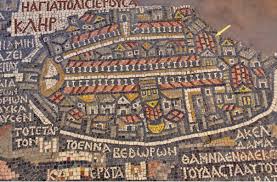 It’s the one with the yellow dome. The Nea Church was completed in A.D. 543, nine years after Justinian recovered the Temple treasures, and as archaeological work there in the 70s has shown, there were indeed large storerooms in this Temple, as Procopius said, for sacred articles.
It’s the one with the yellow dome. The Nea Church was completed in A.D. 543, nine years after Justinian recovered the Temple treasures, and as archaeological work there in the 70s has shown, there were indeed large storerooms in this Temple, as Procopius said, for sacred articles.
It cannot be confirmed that the Herodian temple menorah was actually returned to Jerusalem along with other sacred artifacts. But it seems quite possible, not least because Justinian had built into his palace in Constantinople a mosaic showing the menorah among other objects. He seems to have had the goods! This story makes the script of Indiana Jones and the Last Crusade pale by comparison.



